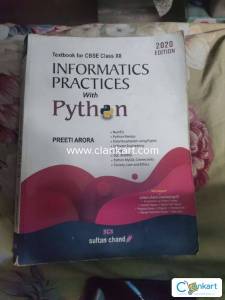Buy used Bachelor of Computer Applications (BCA) books online in India
Buy Second Hand Books, Used Books Online In India
Data Structure Using C
This second edition of Data Structures Using C has been developed to provide a comprehensive and consistent coverage of both the abstract concepts of data structures as well as the implementation of these concepts using C language. It begins with a thorough overview of the concepts of C programming followed by introduction of different data structures and methods to analyse the complexity of different algorithms. It then connects these concepts and applies them to the study of various data structures such as arrays, strings, linked lists, stacks, queues, trees, heaps, and graphs. The book utilizes a systematic approach wherein the design of each of the data structures is followed by algorithms of different operations that can be performed on them, and the analysis of these algorithms in terms of their running times. Each chapter includes a variety of end-chapter exercises in the form of MCQs with answers, review questions, and programming exercises to help readers test their knowledge.
Discrete Mathematics & its Applications
About the Book: Discrete Mathematics and Its Applications The book lays emphasis on mathematical reasoning, combinatorial analysis, algorithmic thinking, and applications and modeling. One of the most accepted books in use, it gives a presentation of the subject in great depth. The text is strengthened with illustrations of variety of real-world applications from different arenas and a host of pedagogical tools which makes it easy to comprehend. About the Author: Kenneth H Rosen Kenneth H Rosen, Visiting Research Professor, Monmouth University, New Jersey
let us c a programming language guide
Learn the hand-crafted notes on C programming Key Features Strengthens the foundations, as a detailed explanation of programming language concepts are given Lucid explanation of the concept Well thought-out, fully working programming examples End-of-chapter exercises that would help you practice the skills learned in the chapterHand-crafted "KanNotes" at the end of the each chapter that would help the reader remember and revise the concepts covered in the chapter Focuses on how to think logically to solve a problem DescriptionThe new edition of this classic book has been thoroughly revamped, but remains faithful to the principles that have established it as a favourite amongst students, teachers and software professionals round the world. "Simplicity"- that has been the hallmark of this book in not only its previous sixteen English editions, but also in the Hindi, Gujrati, Japanese, Korean, Chinese and US editions. This book doesn't assume any programming background. It begins with the basics and steadily builds the pace so that the reader finds it easy to handle advanced topics towards the end of the book.What will you learn C Instructions Decision Control Instruction, Loop Control Instruction, Case Control Instruction Functions, Pointers, Recursion Data Types, The C Preprocessor Arrays, Strings Structures, Console Input/Output, File Input/Output Who this book is forStudents, Programmers, researchers, and software developers who wish to learn the basics of C++ programming language.Table of Contents 1. Getting Started2. C Instructions3. Decision Control Instruction4. More Complex Decision Making5. Loop Control Instruction6. More Complex Repetitions7. Case Control Instruction8. Functions9. Pointers10. Recursion11. Data Types Revisited12. The C Preprocessor13. Arrays14. Multidimensional Arrays15. Strings16. Handling Multiple Strings17. Structures18. Console Input/Output19. File Input/Output20. More Issues In Input/Output21. Operations On Bits22. Miscellaneous Features23. Interview FAQsAppendix A- Compilation and E
Object Oriented Programming in Turbo C++
Object-Oriented Programming (OOP) is the most dramatic and potentially confusing-innovation in software development since the dawn of the computer age. Based on the idea of treating functions and data as objects, OOP results in programs that are more flexible, more easily maintained, and, on the whole, more powerful. Suitable for students, hackers, and enthusiasts, Object-Oriented Programming in Turbo C++ is written by best-selling author Robert Lafore. Step-by-step lessons teach the Basics of Object-Oriented Programming with Turbo C++ and its new Windows-compatible sibling, Borland C++. Object-Oriented Programming in Turbo C++ focuses on C++ as a separate language, distinct from C, and assumes no prior experience with C.
























